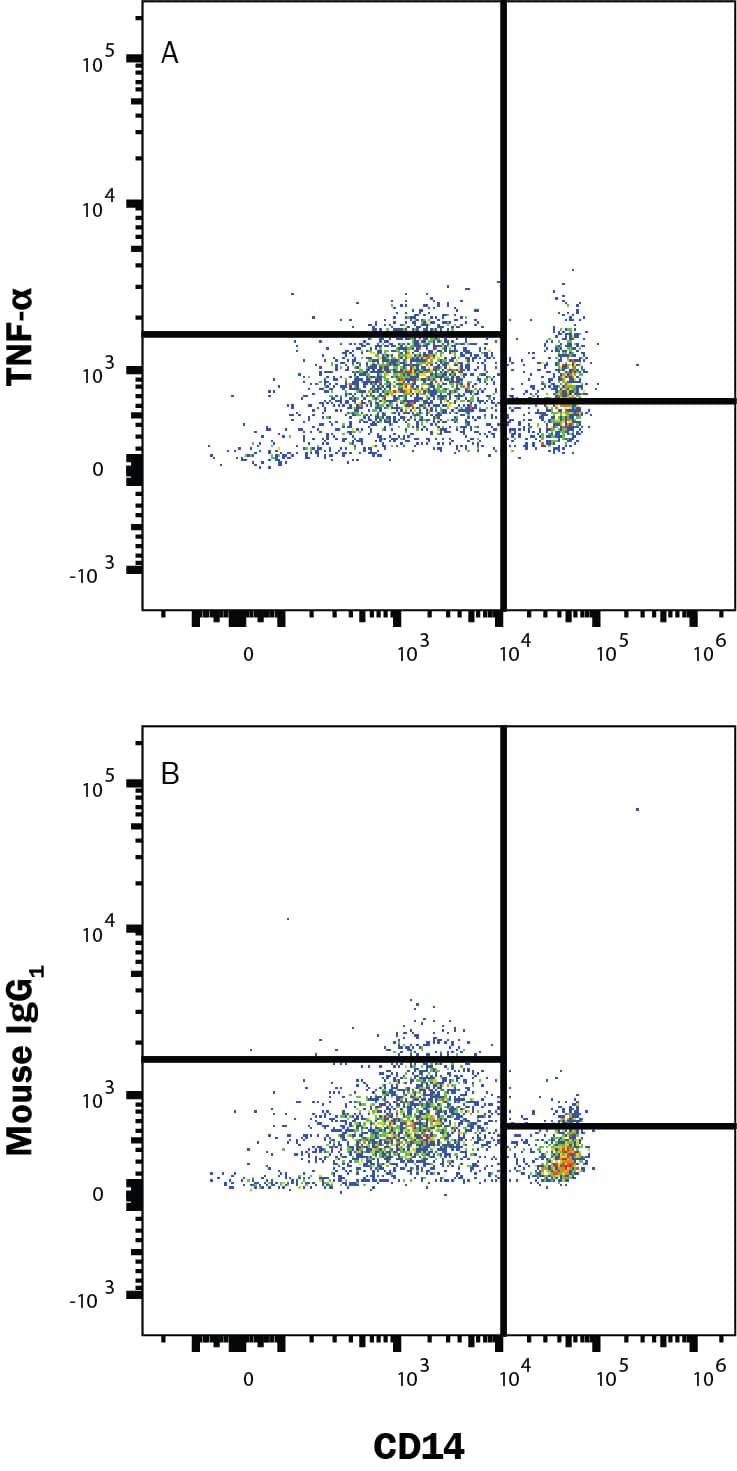Human TNF-alpha Membrane Form Fluorescein-conjugated Antibody Summary
Gly57-Leu233 (predicted)
Accession # P01375
Applications
Please Note: Optimal dilutions should be determined by each laboratory for each application. General Protocols are available in the Technical Information section on our website.
Scientific Data
 View Larger
View Larger
Detection of TNF‑ alpha in PBMC monocytes by Flow Cytometry. Stimulated PBMC monocytes treated with 1 μg/mL LPS at 37 degrees Celsius for 4 hours were stained with Mouse Anti-Human CD14 APC‑conjugated Monoclonal Antibody (Catalog # FAB3832A) and either (A) Mouse Anti-Human TNF‑ alpha Membrane Form Fluorescein‑conjugated Monoclonal Antibody (Catalog # FAB210F) or (B) Mouse IgG1 Fluorescein Isotype Control (Catalog # IC002F). View our protocol for Staining Membrane-associated Proteins.
Preparation and Storage
- 12 months from date of receipt, 2 to 8 °C as supplied.
Background: TNF-alpha
Tumor necrosis factor alpha (TNF-alpha, TNF- alpha, TNFA ), also known as Cachectin and TNFSF2, is the prototypic ligand of the TNF superfamily. It is a pleiotropic molecule that plays a central role in inflammation, immune system development, apoptosis, and lipid metabolism. TNF- is produced by several lymphoid cells as well as by astrocytes, endothelial cells, and smooth muscle cells. Human TNF-alpha consisits of a 35 amino acid (aa) cytoplasmic domain, a 21 aa transmembrane segment, and a 177 aa extracellular domain (ECD). Within the ECD, human TNF-alpha shares 97% aa sequence identity with rhesus and 71%-92% with bovine, canine, cotton rat, equine, feline, mouse, porcine, and rat TNF-alpha. TNF-alpha is produced by a wide variety of immune, epithelial, endothelial, and tumor cells. TNF-alpha is assembled intracellularly to form a noncovalently linked homotrimer which is expressed on the cell surface. Cell surface TNF-alpha can induce the lysis of neighboring tumor cells and virus infected cells, and it can generate its own downstream cell signaling following ligation by soluble TNFR I. Shedding of membrane bound TNF-alpha by TACE/ADAM17 releases the bioactive cytokine, a 55 kDa molecular weight soluble trimer of the TNF-alpha extracellular domain. TNF-alpha binds the ubiquitous 55-60 kDa TNF RI and the hematopoietic cell-restricted 80 kDa TNF RII, both of which are also expressed as homotrimers present on virtually all cell types. Both type I and type II receptors bind TNF-alpha with comparable affinity, although only TNF RI contains a cytoplasmic death domain which triggers the activation of apoptosis. Soluble forms of both types of receptors are released and can neutralize the biological activity of TNF-alpha.
Product Datasheets
Citations for Human TNF-alpha Membrane Form Fluorescein-conjugated Antibody
R&D Systems personnel manually curate a database that contains references using R&D Systems products. The data collected includes not only links to publications in PubMed, but also provides information about sample types, species, and experimental conditions.
5
Citations: Showing 1 - 5
Filter your results:
Filter by:
-
Anti-TNF drives regulatory T cell expansion by paradoxically promoting membrane TNF-TNF-RII bindin--g in rheumatoid arthritis
Authors: Dao Xuan Nguyen
J Exp Med, 2016-06-06;0(0):.
-
Unlike for human monocytes after LPS activation, release of TNF-α by THP-1 cells is produced by a TACE catalytically different from constitutive TACE.
Authors: Moreira-Tabaka H, Peluso J, Vonesch JL, Hentsch D, Kessler P, Reimund JM, Dumont S, Muller CD
PLoS ONE, 2012-03-30;7(3):e34184.
Species: Human
Sample Types: Whole Cells
Applications: Flow Cytometry -
Simultaneous induction of apoptotic and survival signaling pathways in macrophage-like THP-1 cells by Shiga toxin 1.
Authors: Lee SY, Cherla RP, Tesh VL
Infect. Immun., 2006-12-28;75(3):1291-302.
Species: Human
Sample Types: Whole Cells
Applications: Flow Cytometry -
Regulation of peritoneal and systemic neutrophil-derived tumor necrosis factor-alpha release in patients with severe peritonitis: role of tumor necrosis factor-alpha converting enzyme cleavage.
Authors: Kermarrec N, Selloum S, Plantefeve G, Chosidow D, Paoletti X, Lopez A, Mantz J, Desmonts JM, Gougerot-Pocidalo MA, Chollet-Martin S
Crit. Care Med., 2005-06-01;33(6):1359-64.
Species: Human
Sample Types: Whole Cells
Applications: Flow Cytometry -
Tumour necrosis factor-alpha transcription in transferrin-stimulated human blood mononuclear cells: is transferrin receptor involved in the signalling mechanism?
Authors: Lopez M, 21, Rios E, Schlesinger L, Olivares M, Nunez MT, Munoz C
CCR6 chemokine receptor is an important target in inflammatory diseases. Th17 cells express CCR6 and a number of inflammatory cytokines, including IL-17 and IL-22, which are involved in the propagatio, 2003-03-01;120(5):829-35.
Species: Human
Sample Types: Whole Cells
Applications: Flow Cytometry
FAQs
-
Why do FAB210 and IC210 give different intracellular staining results?
FAB210 was developed to detect cells that are expressing cell surface TNF-alpha and the antibody is able to recognize cells that have bound TNF-alpha on their surface through their receptor and membrane bound forms. The IC210 on the other hand detects the cytoplasmic form of TNF-alpha, that is cells which are actively secreting TNF-alpha intracellularly. If FAB210 is used for intracellular staining, there is a chance that antibody will report additive staining of cell surface TNF-alpha as well as intracellular TNF-alpha upon permeabilization.
Reviews for Human TNF-alpha Membrane Form Fluorescein-conjugated Antibody
There are currently no reviews for this product. Be the first to review Human TNF-alpha Membrane Form Fluorescein-conjugated Antibody and earn rewards!
Have you used Human TNF-alpha Membrane Form Fluorescein-conjugated Antibody?
Submit a review and receive an Amazon gift card.
$25/€18/£15/$25CAN/¥75 Yuan/¥2500 Yen for a review with an image
$10/€7/£6/$10 CAD/¥70 Yuan/¥1110 Yen for a review without an image












